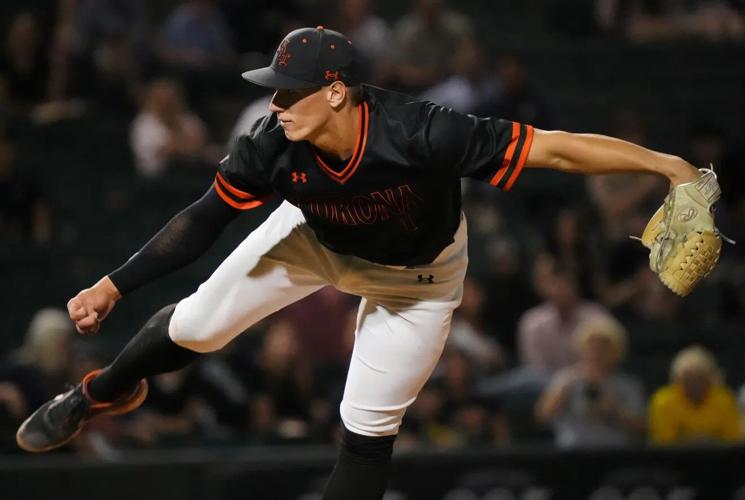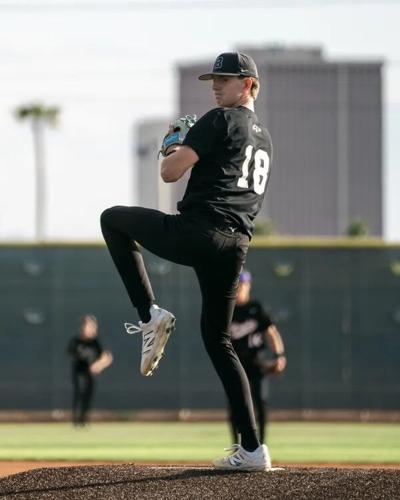PHOENIX — Every summer, top high school baseball players face a career-defining choice: sign a pro contract after being selected in the MLB Draft or honor their college commitments. This year, in the Phoenix metro area, a rising hub for prep baseball, four players appeared on multiple pre-draft prospect rankings.
Highly rated Corona del Sol High School right-handed pitcher Brett Crossland and shortstop Jaiden LoRe, Brophy College Preparatory right-handed pitcher Jack Lafflam, and Hamilton High School infielder Boston Kellner were considered strong draft prospects for the recent two-day event in Atlanta.

Corona del Sol Aztecs’ Brett Crossland (1) pitches against the Casteel Colts during their 6A State Championship game at Tempe Diablo Stadium on May 20, 2025.
Only one was selected: The Baltimore Orioles picked LoRe in the fifth round. Teams have until 5 p.m. EST July 28 to sign their draft picks. If LoRe signs with the Orioles as expected, he will forgo his BYU commitment.
For the others, draft weekend brought a different outcome, a reflection of how the landscape has shifted for high school players in recent years. Thirty-three high school players were drafted in the first 90 picks. As the draft continued, rounds started going by with very few, if any, high school players announced.
People are also reading…
Lafflam isn’t dwelling on it, and he’s turning the page with confidence and a clear sense of purpose.
“It’s really important … because you don’t want to get too comfortable, because those around you will pass by,” Lafflam said. “So just being able to be the hardest worker in the room has really been a big passion of mine.”
Part of the reason for the landscape shift lies in a major structural change to the MLB Draft. Since 2021, the draft, which takes place during All-Star weekend, has included 20 rounds, reduced from 40 as part of the latest collective bargaining agreement between MLB and the players union.
Mike Woods, longtime varsity baseball coach at Hamilton High School, believes the draft’s reduction in rounds, along with changes to college athletics, will continue to steer more high school players toward college baseball.
“Now teams just are not taking flyers on kids,” Woods said. “Just getting drafted out of high school is very difficult. Especially now that they’re getting the name, image and likeness (NIL) money, you know, these guys could get a little bit of money, go to college, develop physically and mentally and then go back into the draft. But the trend is definitely going towards more college players being drafted rather than high school kids. I think that’s going to stay that way for a while.”
Woods points to Hamilton baseball’s 35th draft success story, Gavin Turley, who turned down the Diamondbacks after being selected in the 19th round in 2022. Turley instead developed at Oregon State and became a fourth-round pick of the Athletics this year. Fellow Hamilton alum Roch Cholowsky is on the short list of potential 2026 No. 1 picks following a highly successful sophomore season at UCLA this spring.
Reflecting on the success of players like Turley and Cholowsky, Woods emphasized that talent and drive ultimately make the difference.
“I mean, they already had the tools, they already had the makeup, and they were motivated — they were just kind of special players,” Woods said. “That’s why they got drafted. I’d like to think maybe we helped them a little bit, but they’re the reason that they get drafted due to their work ethic and the time they put in.”
Unlike the NBA and NFL drafts, MLB’s version is heavily influenced by financial considerations. Each pick comes with an assigned slot value, with the highest bonuses awarded in the early rounds. For instance, the Washington Nationals could pay No. 1 pick Eli Willits, a 17-year-old shortstop, over $11 million. Meanwhile, LoRe’s pick value is $452,000, although it is uncertain whether he will sign for that much.
High school players often have more negotiating leverage than college players. Their flexibility and the financial risk teams face for exceeding their bonus pool lead most clubs to draft strategically. They often select college players willing to sign for less, so the savings can go toward overslot deals, bonus offers above the assigned pick value that usually convince top high school players to bypass college.
Despite their leverage, high school players come with greater risks, as they’re less experienced and often require more development time in the minors. Additionally, college baseball has become an increasingly valuable development path. In fact, a high school right-handed pitcher has never been selected No. 1 in the history of the draft.
Lafflam spent considerable time weighing the life-changing decision during the pre-draft process, especially as his stock continued to rise. “It’s kind of one I’ve been dealing with the past year and a half, just walking through the steps with my advisors and coaches and those who support me,” Lafflam said. “It’s ultimately going to come down to what it would take to buy me out of my college experience, and start my pro career a little early or whether I should wait three years.

Brophy's Jack Lafflam winds up to pitch on April 3, 2025, at Brophy College Prep in Phoenix.Â
“It’s definitely been a process of putting my name out there, performing in front of scouts, having meetings with teams and just what I’m supposed to expect if I’d take that route.”
After 20 rounds and 615 picks, Crossland, Lafflam and Kellner were not selected, likely a result of their strong college commitments and somewhat uneven senior seasons.
Though the draft didn’t go as hoped, Lafflam knows his experience and work ethic will serve him well down the road.
“I played four years of varsity baseball in high school, was introduced to really competitive baseball at a young age, and then played a lot of high-level competitive travel baseball and a lot of showcases and events that I was invited to,” he said. “So I guess over the years, it’s kind of just built up on me.”









